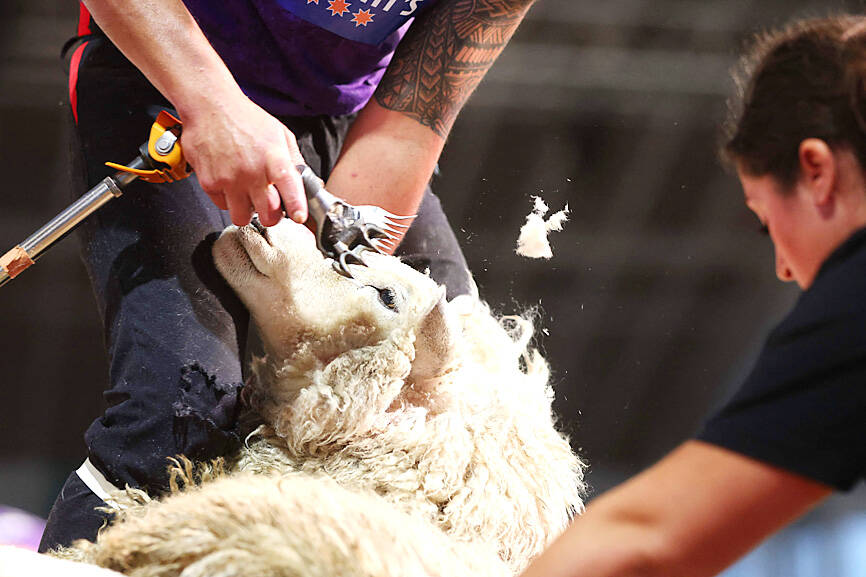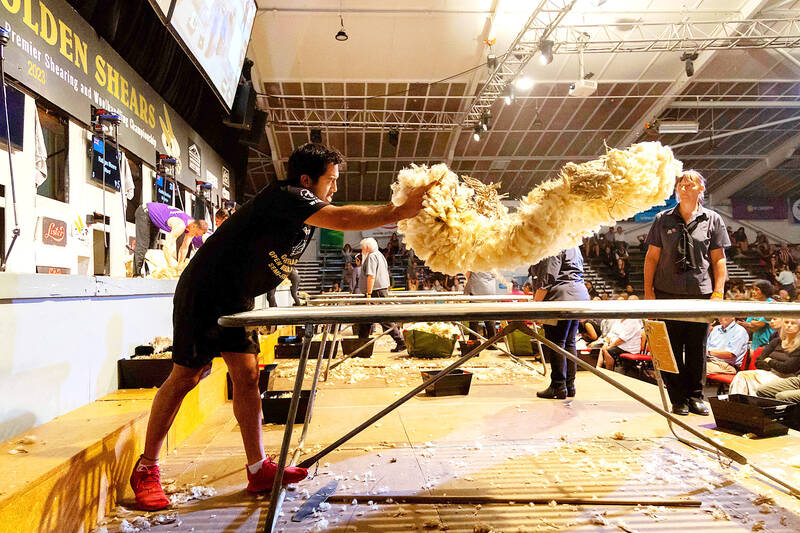In New Zealand’s close-knit shearing community, Joel Henare is regarded as a Lionel Messi, Tiger Woods or Jonah Lomu — a G.O.A.T. in the sheep sheds.
Now 31, he first stepped into the bright lights of competitive shearing at the lambkin age of 12.
Henare has since notched 132 competition victories in wool handling — the high-speed art of separating off-cuts from a sheared fleece. In his discipline, he is considered to be the best.

Photo: AFP
He begins his work with an artistic flick, spreading the matted fleece over a table, before expertly trimming, snipping and slicing unwanted parts in rapid succession.
Within 60 seconds, he is on to the next one.
Henare dominated the field at this month’s Golden Shears, a prestigious event that draws shearers and wool handlers from all over the world to Masterton, a provincial farming town in New Zealand with a population of 27,000.

Photo: AFP
After gaining his ninth wool handling title in a row, drenched in sweat and panting, Henare put his success down to hard work, discipline and quick thinking.
“You need to be fit in your body physically, but you also need to have the mental strength,” he said. “Consistency is key. You need to have your wits about you at all times.”
New Zealand, home to 5 million people and 25 million sheep, is one of the world’s main wool exporters, last year sending US$284 million worth overseas.
Rising farming costs and falling wool prices have seen national sheep figures dwindle from a high of 72 million in the 1980s.
However, their specialized skills mean shearers and wool handlers remain in demand despite falling sheep numbers, New Zealand Shearing Contractors Association president Mark Barrowcliffe said.
“Shearing is facing many different challenges, including a labor shortage, so there will always be work for a well-trained wool handler or shearer,” he said.
Competitive shearing and wool handling is serious business in New Zealand, which even has a designated federation — Shearing Sports NZ — to oversee competitions.
Professional shearers need dexterity and incredible stamina to clip hundreds of sheep — each weighing about 60kg — during a typical eight-hour work day.
Wool handling also demands a well-organized approach “to do it properly every time, not just up on stage, but anywhere you go in the world,” Henare said.
Golden Shears organizers paint Henare as “the Jonah Lomu of shearing sports,” invoking the storied legacy of the New Zealand rugby great.
However, this “greatest of all time” quit full-time shearing work four years ago and competes just as a hobby.
Techniques, tricks and tips on how to handle sheep and their wool are passed down through the generations in New Zealand’s sheep sheds, and Henare hails from a dynasty.
His grandmother was a champion wool handler on the plains of Otago. Two of his great uncles were shearers who competed in Golden Shears finals in the 1960s.
Already young pretenders to Henare’s status as a Golden Shears champion are emerging.
Among them are teen shearing sensation Reuben Alabaster, who broke the solo world record in December last year by shearing 746 sheep in eight hours.
Alabaster said he was often worn out at the end of a competition, “but you just push through if it’s a dream you’re chasing.”
“It’s amazing what your body can do,” he added.
Like Henare, the 19-year-old grew up around sheep sheds, learning his trade since childhood from family, such as his cousin Sheree Alabaster — the 2008 wool handling world champion.
Shearing also comes down to training techniques.
“It’s all about positioning, some sheep sit better than others,” Reuben Alabaster said.
“It’s a lot nicer for the sheep if you’re holding them right too. Some just have an attitude and don’t want to be shorn at all,” he said, adding that “Even the best shearers in the world still get kicked.”

When Shanghai-based designer Guo Qingshan posted a vacation photo on Valentine’s Day and captioned it “Puppy Mountain,” it became a sensation in China and even created a tourist destination. Guo had gone on a hike while visiting his hometown of Yichang in central China’s Hubei Province late last month. When reviewing the photographs, he saw something he had not noticed before: A mountain shaped like a dog’s head rested on the ground next to the Yangtze River, its snout perched at the water’s edge. “It was so magical and cute. I was so excited and happy when I discovered it,” Guo said.

Chinese authorities said they began live-fire exercises in the Gulf of Tonkin on Monday, only days after Vietnam announced a new line marking what it considers its territory in the body of water between the nations. The Chinese Maritime Safety Administration said the exercises would be focused on the Beibu Gulf area, closer to the Chinese side of the Gulf of Tonkin, and would run until tomorrow evening. It gave no further details, but the drills follow an announcement last week by Vietnam establishing a baseline used to calculate the width of its territorial waters in the Gulf of Tonkin. State-run Vietnam News

TURNAROUND: The Liberal Party had trailed the Conservatives by a wide margin, but that was before Trump threatened to make Canada the US’ 51st state Canada’s ruling Liberals, who a few weeks ago looked certain to lose an election this year, are mounting a major comeback amid the threat of US tariffs and are tied with their rival Conservatives, according to three new polls. An Ipsos survey released late on Tuesday showed that the left-leaning Liberals have 38 percent public support and the official opposition center-right Conservatives have 36 percent. The Liberals have overturned a 26-point deficit in six weeks, and run advertisements comparing the Conservative leader to Trump. The Conservative strategy had long been to attack unpopular Canadian Prime Minister Justin Trudeau, but last month he

Four decades after they were forced apart, US-raised Adamary Garcia and her birth mother on Saturday fell into each other’s arms at the airport in Santiago, Chile. Without speaking, they embraced tearfully: A rare reunification for one the thousands of Chileans taken from their mothers as babies and given up for adoption abroad. “The worst is over,” Edita Bizama, 64, said as she beheld her daughter for the first time since her birth 41 years ago. Garcia had flown to Santiago with four other women born in Chile and adopted in the US. Reports have estimated there were 20,000 such cases from 1950 to